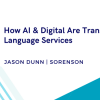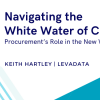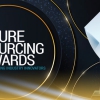We caught up with Ed earlier this month at the SIG Global Summit in Carlsbad, California (where he also participated in our most recent Outsource Talks webinar: see below for more) to get his take on current trends in the space, his critical input into SIG's Executive Immersion Program (EIP), and the evolution of the role of the lawyer in sourcing and outsourcing - and much, much more...
Outsource: Ed, welcome (back) to Outsource! You’re quite a well-known figure in the space and our readers may well be familiar with you from some previous contributions, but for those who aren’t could you give us a quick precis of your background and current role?
Ed Hansen: Thanks! I’m a partner in the New York office of Morgan Lewis and specialise in customer-side deals where technology or outsourcing is being used as a conduit for business transformation. As for background, I’ve been practicing in the technology/outsourcing space for over 20 years. When I started in this business, there really weren’t many procurement groups who could do this kind of work, so I got to work on deals from the pre-RFP stages right through expiration. I have also had the privilege to work with many of the same clients for several years (in some cases decades). This has given me a whole-deal life cycle perspective that allowed me to experience and influence how our contracting and negotiating tactics affected the execution and success of our deals.
O: We're here at the SIG Summit in Carlsbad so let’s look at that for a moment: as a long-time friend of SIG what do you think of this Summit – and how have the conversations at those events evolved while you’ve been involved with the organisation?
EH: This is a great question. First of all, I like the conferences. They’re always well-run, in good locations and, for the most part, have excellent content. But aside from the content, I really enjoy the networking events. As you know, if you go to a SIG conference as a provider, you have to sign a code of conduct that prohibits you from hard marketing. For me this is a blessing, because it lets me just talk to people without them having to worry about being chased down for business. In my case, this is just what I need from a conference like this.
As a customer-side deal lawyer in this space, SIG is a great place to see what’s going on from the customers’ perspective, see how they’re meeting their challenges and get a feel for how we can make our practice work to better suit the needs that are out there in the market. In some cases this may involve being reactive to a particular need. But in many cases, we think about whether there is additional thought leadership that we can bring to the conversation that would help improve the discussion. SIG then gives us a great platform to take that thought leadership and share it with others. It’s a nice cycle, and a very productive ecosystem.
O: You’ve also been involved with SIG recently in the form of the Executive Immersion Program. Could you tell our readers a little about this and why you’re such a fan?
EH: I came to the Executive Immersion Program by accident. When I get the opportunity to speak at the Global Summits, I try to speak about something that the audience can just take away and use. The problem is that some of this material is complicated and some requires foundational work before it makes sense. Some SIG execs and I were talking about this, and came up with the idea of developing a contracting masterclass where we could take the time required to get more in-depth and complex ideas across, and do it in a way that is tailored to experienced professionals in an interactive format.
The first year we did the class, we ran for three hours and had material left over at the end. Based on the feedback we got from the class, we expanded the class to five hours this year, and still had material left over at the end. Again, based on feedback, next year we will probably expend it at least another hour, and incorporate some more of the interactive content that we didn’t have time for this year. We are also talking about rolling it out to different regions.
The exciting part for me is that this format gives me an opportunity to develop a program that goes into enough depth to really drive home the practice and theory behind the deal process – which is something that I personally care about deeply. For the class participants, they are getting a unique, highly interactive, problem solving environment to come and talk contracts in. The feedback loop in the class is great. We’re presenting what I think is interesting material, but because of the level of practitioner we get in these classes, the audience members are learning from each other, and we are learning from the participants. This is why we do this as a masterclass.
With the longer format we can get much more into the “art” of the deal process than we could in a shorter time-frame. For example, this year we discussed such topics as how to make strategic use of the contract, how the contracting process can be a pillar of an effective change management program, drafting techniques, how to tailor your contracting process to your deal type, transaction cost effects, behavioural economics, incomplete contract theory, and risk bifurcation. For this last class we had Bill Huber and Tyrone Magbee from Alsbridge join us as well. In addition to contributing very insightful ad hoc comments as we progressed through the program, Bill and Tyrone presented an interesting segment on process insights for software acquisition.
From a presenter’s perspective it’s easy to like a program like Executive Immersion that allows us to create an environment that is so interactive. It allows us to share some of our experience, but also really taps into a very high level of expertise in the community.
O: There is a real sense at the Summit of the rapid pace of change in the industry – in fact, in business generally – thanks to the content of the keynotes in particular. How well do you think the sourcing/outsourcing community generally is adapting to this dynamic change?
EH: I can’t think of a period since I started practicing when you couldn’t have written this question. So it may be true that we are changing at a historic rate, but since change is an exponential function, we are always changing at a historic rate. Obviously the pace of change is real. But I think the challenge is to differentiate between real change, change that’s not really all that remarkable but is being marketed as groundbreaking, and change that may be impacting a business area but that doesn’t fundamentally change the rules of the areas that support it. Also keep in mind that marketers have a vested interest in over-hyping all things “change”. But from an operational perspective, many businesses tend to be more circumspect.
I think you saw this in the gradual adoption of cloud computing, and you’re seeing this to a large extent in the convergence of outsourcing and robotics. Despite the RPA marketing tidal wave, providers and customers are taking a measured approach. That said, the influx of technology change usually creates a tipping point where the technology becomes dominant. The problem is that contracts can create serious lag times between introduction and adoption that can be detrimental. With respect to operational technology, the trick is to understand and try to anticipate how this impact can manifest and build the flexibility into your contracts so that you can take the time you feel you need to study and digest a technology, but then can be ready to adopt when you feel it’s necessary without turning the deal economics upside-down.
O: How are those trends being reflected in the conversations you’re having with clients now? We hear a great deal about the way deals are changing; how are those changes manifesting themselves in the way you’re working?
EH: First of all, I think it’s dangerous to generalise. For example, it’s very popular to say that big outsourcing is dead or dying. Yet just this past year I did a $2.5 billion outsourcing, and started a second multi-tower BPO a week after that one closed. And the first one was a deal of first impression – so they’re still out there. This also varies by industry. That said, with the “digital revolution” we are seeing more multi-vendor environments, and we spend quite a bit of time working with clients thinking about extended enterprise ecosystems and looking at deal strategies that transcend multiple engagements. This is certainly impacting deal work, but if anything it is putting more emphasis on the holism of the environment which is no longer reflected in single contracts.
From a contracting perspective, among other things, this means that we have to think in terms of contract “systems” rather than individual deals. This is one of those concepts that is easy in the abstract, but challenging in practice, and goes far beyond the standardised MSA model. In order to get the benefit from a true multi-vendor environment, the parties have to act and interact almost as though they are in-house. This is a result that takes careful planning and sourcing/contracting process excellence, particularly since there can easily be a weak link in the environment that can be real drag on ROI.
On the technology innovation side, we’re starting to see more RPA/FTE hybrids proposed in BPO deals. For example, on a recent deal we saw all vendors propose at least 30% automation across the board, with various subsets of that as cognitive automation or robotics. Of course, going back to the hype around change, “automation” as part of a BPO solution is not necessarily new, and the cognitive part of this across all of these providers is as yet not as well defined in the solution as we would like.
There was an interesting study recently suggesting that customers and providers in the BPO space look at the providers’ role very differently. Apparently, the providers see themselves as the purveyor of everything innovative and new. But their customers see them as hanging on to old ways even though the customers are hungry for innovation. If this study is to be believed, the multi-billion dollar question is whether the providers can step up and fill a gap that they know exists but are, ironically, too change-resistant to fill. I think they have a fighting chance, particularly if some of the new sourcing models gain momentum. For example, there’s an interesting model studied recently in a paper coming out of NYU called 'The Long Tailed Strategy for IT Sourcing', which basically looks at having an environment that includes certain 'big O' enterprise outsourcing, but also locally-driven smaller relationships that act as an innovation engine for the company. This certainly feels right, and could lead to an innovation revelation in the 'big O' outsourcing. But I guess we’ll have to see.
O: Do you see the role of lawyers in the outsourcing space increasingly moving into the kind of work which might previously have been the domain of the outsourcing advisory firms? There’s been quite a bit of discussion around this recently; what’s your perspective on the topic?
EH: I’m not a fan of this question because I don’t like to lump all lawyers or all consultants into groups like that. In many ways sourcing is becoming more, not less, complex, even if it’s a bit less mysterious than it used to be. So I think you’ll see sourcing advisors growing their ability to function strategically and retool so they can play a bigger role in designing delivery ecosystems. As far as the lawyers are concerned, I’ve always thought that the legal roles and the business roles should converge on these deals. Even today, the lawyers who provide the most value understand and have the skills to participate in the sourcing and business functions. Conversely, the best advisors and subject matter experts are comfortable getting involved in the documents. Hopefully as the environment becomes more complex, we’ll see more emphasis being put on assembling teams comprising members who possess the cross-functional skills required to hit the objectives of these new strategies.
O: What’s most interesting you about your own job today and how’s that changed since the start of your career?
EH: I should probably talk about technology changes, or developments in international privacy laws or compliance landscapes. But, honestly, after all these years I still believe the most interesting part of this job is the people aspect. I know that sounds like a cliché, but when this job is done right it’s really a people business at its core. This is true I think on many levels.
First, there’s the relationship with your client. Hopefully you will be accepted as a full partner onto a deal team of people who are often experts in their fields. But if you are new to the client, you carry all of the baggage of the lawyers who came before you. If the prior lawyer didn’t add the value that he or she should have, as the new guy you will have to truly earn the team’s trust. This creates an interesting challenge because you have to be respectful of the team and its people (which may include some very smart and experienced people who do not have experience working deals like these), but have to be vocal enough to add value. Over time this works itself out, but in the short run striking that balance can be a challenge.
Then there’s the relationship with the opposing side. I happen to believe, and experience has borne out, that the best deals are the ones where the parties view the contracting process (which starts before the RFP goes out) as an opportunity to create value and solve problems. Having the right teams with the skillsets to handle discussions fluently and achieve real value greatly influences the relationship between the sides. As the deal lawyer you have a real opportunity to help set the tone of the discussion. An added benefit of a problem-solving approach is that you usually come to a much better contract that way as well – a contract that will be dog-eared because it provides guidance that the parties can use. Of course, a contract like this will also be a strong, fair, enforcement tool when necessary.
Even outside the contracting process, the success or failure of the deal will often be people-driven. Taking the effects that contract terms and deal structure can have on people into account can often make the difference between ultimate success and finding yourself in a death spiral.
O: Finally, if you could wave a magic wand and change one thing in today’s business world, what would it be?
EH: The deals we do typically involve significant business transformation and are often part of a larger program that will be profoundly impactful. We have the privilege of being a part of deal teams that often have the movers and shakers of the organisation on them - folks who play the role of change agent in their organisations. These deals often promulgate new technology, involve innovation and interesting pricing models, and, in some cases, are critical to the customer’s future success.
Against this backdrop, we have found that the best deals tend to happen when the teams get aligned on the objectives of the deal, connect as people, and start solving problems and looking for opportunities to work together. So I guess if I could wave a magic wand, it would be to create a work environment where there’s enough deal-making virtuosity for people to feel safe enough to bring their creative energy to bear on what they do. It’s amazing what a good deal team can accomplish and the speed with which they can accomplish it when they can work in an environment that fosters a creative mind set.
To hear Ed Hansen speak on Outsource Talks Episode 8 - live from the SIG Summit - click here for the registration page.




